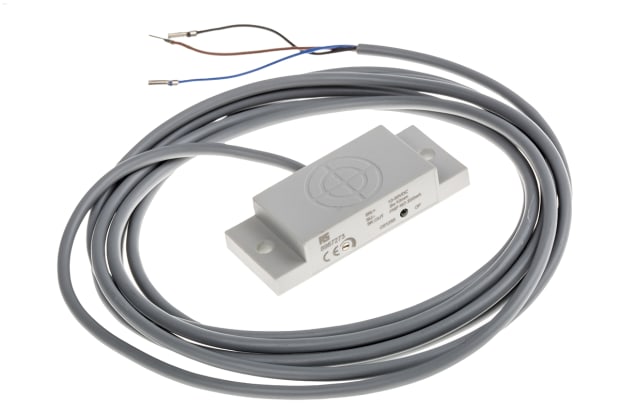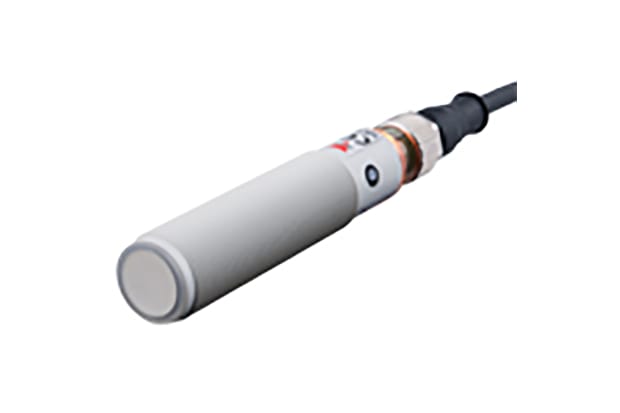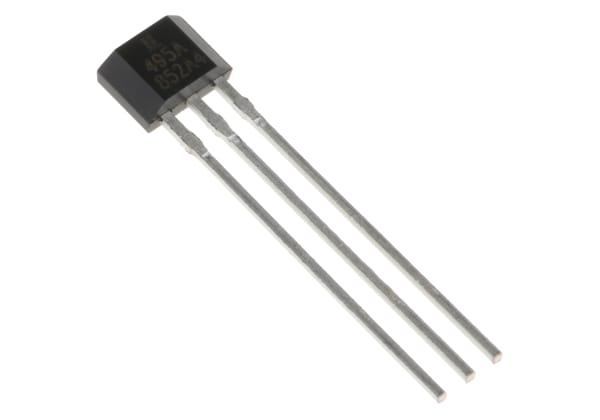- Published 24 Jan 2023
- Last Modified 29 Aug 2023
- 7 min
A Complete Guide to Proximity Sensors
Our guide will help you understand what proximity sensors are, how they work, and the different types available.

What are Proximity Sensors?
A proximity sensor is a component which is designed to detect the absence or presence of an object without the need for physical contact. They are non-contact devices, highly useful for working with delicate or unstable objects which could be damaged by contact with other types of sensor.
This non-contact operation also means that most types of proximity sensor (excluding types such as magnetic proximity sensors) have a prolonged lifespan. This is because they have semiconductor outputs, meaning that no contacts are used for output.
Proximity sensors are designed to provide a high-speed response (the interval between the point when the object triggers the sensor and the point when the output activates). Different types use varying sensing technologies but they all have the same purpose.

What are Proximity Switches?
Proximity switch is a term often used interchangeably with proximity sensor, but the two should not be confused. As explained above, a proximity sensor is a non-contact component which detects the presence of objects within its sensing range. On the other hand, a proximity switch is a specific component which opens or closes the electrical circuit when the sensor detects the absence or presence of an object.
How Do Proximity Sensors Work?
In the simplest terms, proximity sensors work by transmitting data about the presence or motion of an object into an electrical signal. They output an ON signal when the object enters their range. There are some key differences in the way that different proximity sensors work, as explained below:
Capacitive Proximity Sensor Working Principle
Capacitive proximity sensors work by detecting changes in capacitance between the sensor and an object. Factors such as distance and the size of the object will affect the amount of capacitance. The sensor simply detects any changes in capacity generated between the two.
Inductive Proximity Sensor Working Principle
Inductive sensors work by detecting eddy currents causing magnetic loss, generated by external magnetic fields on a conductive surface. The detection coil generates an AC magnetic field, and impedance changes are detected as a result of generated eddy currents.
Magnetic Proximity Switches Working Principle
Magnetic proximity switches are comparatively simple and straightforward. The reed end of the switch is operated by a magnet. When the reed switch is activated and ON, the sensor also turns ON.
It is also worth noting that proximity sensors are not affected by the surface colour of the object detected. They rely purely on physical movement and the motion of an object, so its colour does not play a role in the effectiveness of the sensor.
Proximity Sensor Applications
Proximity sensors can be used in a range of environments and for many different applications. They are beneficial to any application where it is necessary to detect an object in a defined range. This could include:
- Standard object position detection
- Transportation, logistics, and supply chain
- Inspection and quality assurance
- Process control
- Level detection
- Food processing and manufacturing
- Agriculture
They can also be used in environments where oil or water is used, giving them a firm advantage over alternative methods of detection. Capacitive proximity sensors can detect media such as water, resin, and metal, dependent on the dielectric constant of the object. Different types of sensor are best suited to detecting different objects, as explored below:
- Capacitive proximity sensors – metals, liquids, water, resin, powders
- Inductive proximity sensors – metals including aluminium, copper, brass, and iron
- Magnetic proximity sensors – magnets
Proximity sensors are also suitable for use in environments where the temperature fluctuates, or extreme temperatures are commonplace. Although temperature compatibility will depend on the specific model, as a general rule, proximity sensors can be used in temperatures ranging from -50°C to 100° Celsius.
Types of Proximity Sensor
There are three main types of proximity sensor – capacitive, ultrasonic, and inductive. Each has specific characteristics and is best suited to different applications. You can read more about each type in the sections below:

Capacitive Proximity Sensors
Capacitive proximity sensors feature a pair of parallel plates, similar to a standard capacitor. They work when an object produces changes in capacitance, triggering the sensor. Capacitive sensors are designed for use with non-ferrous materials and are ideal for close-range applications such as level detection and monitoring.
It should also be noted that capacitive sensors can be affected by their environment and possible interaction with other sensors. This could include anything from the ambient temperature to other objects in the vicinity. As a result of this, precautions should be taken when installing these sensors to avoid interference from other objects or sensors.
What to Consider when Selecting a Capacitive Proximity Sensor
Several key factors should be taken into consideration when you are choosing a capacitive proximity sensor. It is important to select the best product for your requirements, so ensuring the best fit is essential. Factors and features to consider include:
- Body style (barrel or block)
- Switching output type (NPN or PNP)
- Output function (NO or NC)
- Detection and sensing range
- Target type (i.e. what it senses)
- IP rating
- Installation type (flush or non-flush)
- Whether it is shielded, partially shielded, or unshielded
- Response time
- Possible applications

Ultrasonic Proximity Sensors
Ultrasonic sensors employ the use of sound waves which are either reflected or absorbed by any objects within the sensing range. They are versatile and can be used with a wide range of materials and object types. Ultrasonic sensors are also relatively high-speed so can be used for detection over longer distances than alternative types. They are also ideal for detecting objects with varying surface properties. Just a few example applications include continuous level control and industrial automation systems.
What to Consider when Selecting an Ultrasonic Proximity Sensor
As there are so many different subtypes available, choosing the right ultrasonic sensor for your requirements is essential. Consider the following factors when making your decision:
• Switching output type (PNP or NPN)
• Transducer or ultrasonic frequency
• IP rating
• Whether it is shielded, partially shielded, or unshielded
• Intended application
• Body style
• Sensing range
• Target type (i.e. what it senses)
• Installation type (flush or non-flush)
• Response time

Inductive Proximity Sensors
Inductive proximity sensors feature a wound iron core. As an object enters the sensing range, the inductance of the coil changes, activating the sensor. These components are used with ferrous materials, typically at close-range, and some types may also be found in hazardous environments.
Similarly to capacitive proximity sensors, inductive sensors can also be affected by interaction with other sensors and ambient environmental influences. Careful installation will be required to ensure the sensor is effective and is not adversely affected by any surrounding sensors or metallic objects.
What to Consider when Selecting an Inductive Proximity Sensor
As with all types of proximity sensor, many variables can influence selecting an inductive proximity sensor. Choosing the right type is important, so consider these factors when making your decision:
- Application/s
- Whether it is shielded, partially shielded, or unshielded
- IP rating
- Switching frequency
- Switching output type (NPN or PNP)
- Response time
- Installation type (flush or non-flush)
- Target type (i.e. what it senses)
- Sensing range
- Body style
Magnetic Proximity Sensors
Magnetic sensors are designed to measure the presence or absence of an object. They achieve this by using an external magnetic field, and as the name suggests, they only work with ferromagnetic objects. These components are typically high-speed, making them suitable for measuring fast rotational velocity, for example.
What to Consider when Selecting a Magnetic Proximity Sensor
For a magnetic proximity sensor to perform optimally, the most suitable product for the application must be used. These factors should help you to choose the best magnetic proximity sensor for your requirements:
- Body style
- Sensing range
- Target type (i.e. what it senses)
- Magnetic alignment
- Magnetic sensitivity
- IP rating
- Switching output type
- Switching frequency



